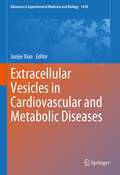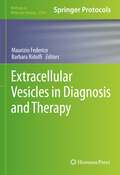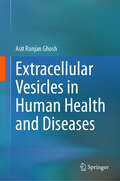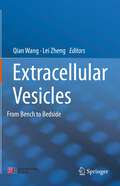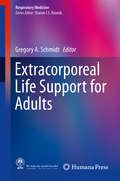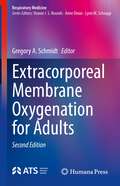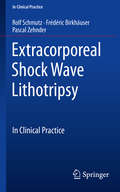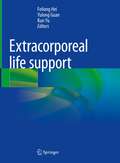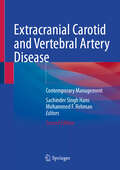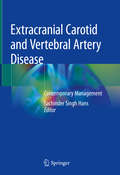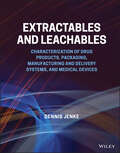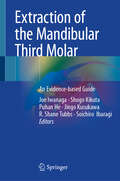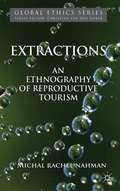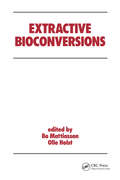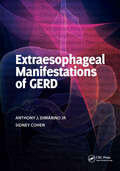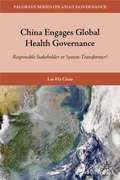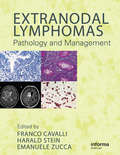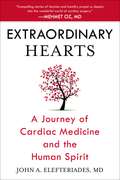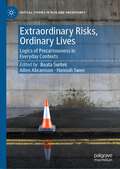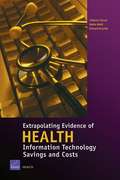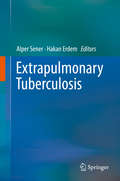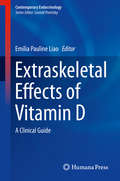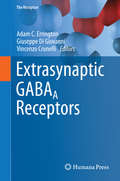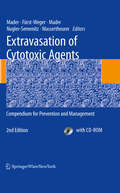- Table View
- List View
Extracellular Vesicles in Cardiovascular and Metabolic Diseases (Advances in Experimental Medicine and Biology #1418)
by Junjie XiaoThis book provides the latest research progress on Extracellular vesicles (EVs) in cardiovascular and metabolic diseases. EVs are small bilayer lipid membrane vesicles released by cells and function for intercellular communication. Increasing evidence has shown that EVs play crucial roles in cardiovascular and metabolic diseases, which seriously threaten human health worldwide. The book contains four sections: 1) Extraction Methods; 2) EVs in Cardiovascular Diseases; 3) EVs in Metabolic Diseases; and 4) Therapeutic Implications. This book is useful for biologists, cardiologists, cardiovascular surgeons, endocrinologists, internists, nurses, undergraduate and graduate students in medicine and cell biology, and others interested in cardiovascular and metabolic medicine.
Extracellular Vesicles in Diagnosis and Therapy (Methods in Molecular Biology #2504)
by Maurizio Federico Barbara RidolfiThis detailed book provides an exhaustive picture of current methods to detect, isolate, and analyze extracellular vesicles (EVs) from diverse sources, now seen as potential disease biomarkers as well as tools for the development of new therapies. Beginning with a section on detection and isolation of EVs, the volume continues with chapters covering different methods to isolate and quantify EVs from specialized tissues/organs and body fluids, methods devoted to analyzing EV components, as well as cutting-edge methods to engineer EVs. Written for the highly successful Methods in Molecular Biology series, chapters include introductions to their respective topics, lists of the necessary materials and reagents, step-by-step, readily reproducible laboratory protocols, and tips on troubleshooting and avoiding known pitfalls. Authoritative and practical, Extracellular Vesicles in Diagnosis and Therapy serves as an ideal guide for researchers seeking to learn more about the complexities of cell-to-cell communication.
Extracellular Vesicles in Human Health and Diseases
by Asit Ranjan GhoshThis book reviews the physiological and therapeutic applications of extracellular vesicles (EV) of different cell types. The initial chapter of the book focuses on their evolution, physiological functions, inter- and intra-cellular communication, and their strategic applications in defining different health disorders including aging, pathogenicity, toxicity, and drug delivery. The chapter also provides an overview of recent technologies for EV isolation, analysis, and quantification. The chapter also examines the role of EVs in viral and bacterial pathogenesis and discusses the emerging potential of EVs as diagnostic and therapeutic tools. It also discusses the emerging role of EVs including endosome-derived exosomes and fragments of the cellular plasma membrane in intercellular communication by transporting messenger RNA, microRNA (miRNA), and proteins. The book further explores the potential of membrane vesicles in the prevention, diagnosis, and treatment of inflammatory diseases,metabolic disorders, cardiovascular diseases, and neurodegenerative disorders. This book address researchers, clinicians, and doctoral and graduate students working in cellular molecular biology, cancer biology, infectious diseases, molecular medicine, biomedicine, neurobiology, microbiology, and translational medicine.
Extracellular Vesicles: From Bench to Bedside
by Qian Wang Lei ZhengThis book aims to provide a comprehensive and systematic understanding of research on extracellular vesicles (EVs). Extracellular vesicles, including exosomes and microvesicles, are nano-sized lipid bilayer encapsulated membranes carrying proteins, lipids, nucleic acids. They are shed by the majority of the cells into the extracellular milieu and present in many biological fluids (blood, urine, saliva, breast milk, cerebrospinal fluid, follicular fluid, semen, lung lavage, and tears). With numerous research publications in recent years, the study of EVs is the emerging field across plenty of disciplines. Many researches and efforts have shown their biogenesis, multiple roles in physiological and pathophysiological processes, and their potential roles as therapeutic agents. The book is organized by outstanding scientists in EV field from the Chinese Society for Extracellular Vesicle (CSEV). It covers the biological basic research of EVs, especially on technologies and methods, as well as the clinical application of EVs as biomarkers for disease diagnosis and therapy.
Extracorporeal Life Support for Adults
by Gregory A. SchmidtThis book presents a concise, evidence-based review of extracorporeal life support (ECLS) for adult diseases. It describes the use of ECLS with patients who are experiencing severe hypoxemic respiratory failure (ARDS and pneumonia), ventilatory failure (status asthmaticus and COPD), cardiogenic shock and circulatory or gas exchange failure following complications in cardiothoracic surgery, as well as its use as a bridge to lung transplant. Historically, clinicians have used ECLS as a last resort; however, this text details the technological improvements, evidence of improved outcomes and adverse consequences of alternative treatments that are causing this modality to be more commonly adopted. Topics include a description of the complex physiology and technology underlying ECLS; the evidence base for its use in specific clinical conditions; vascular access techniques; daily management of the circuit and patient; guidance regarding the weaning and decannulation process and recommendations for crisis management and rehabilitation related to ECLS. Extracorporeal Life Support for Adults is ideal reading for practicing physicians, nurses, perfusion specialists, therapists and critical care trainees who are considering whether to refer their patients for ECLS or are already providing ECLS and are seeking a practical reference to best practices and updated information.
Extracorporeal Membrane Oxygenation for Adults (Respiratory Medicine)
by Gregory A. SchmidtThis new edition presents an evidence-based review of extracorporeal membrane oxygenation (ECMO) for adults, with a particular focus on veno-venous (VV) ECMO. Due to the dramatic impact of COVID-19, the number of institutions offering ECMO, thus the number of clinicians performing ECMO (or referring their patients for ECMO), has exploded in a truly unprecedented way. While the pandemic may fade, programs built in response will survive by extending the application of ECMO to previously overlooked populations.This fully updated second edition refines its focus to VV ECMO, which has seen the most dramatic increase and relevance. This allows expert authors to go further in depth regarding VV ECMO and provide readers with better guidance from the physiology of VV ECMO to weaning and decannulation. Several areas have been expanded, including anti-thrombotic approaches; how to set the mechanical ventilator and judge the complex interactions between patient, ventilator, and ECMO circuit; assessing the systemic circulation during VV ECMO (especially right ventricular function and intravascular volume); and recognizing membrane lung dysfunction. Finally, new chapters addressing how the VV-capable clinician should think about VA ECMO and how to incorporate ethical principles in patient selection and withdrawal of ECMO have been added.This is an ideal guide for intensive care and respiratory medicine specialists, fellows training in critical care, ECMO specialist staff, perfusionists, nurses, and respiratory therapists.
Extracorporeal Shock Wave Lithotripsy: In Clinical Practice (In Clinical Practice)
by Rolf Schmutz Frédéric Birkhäuser Pascal ZehnderThis book is a comprehensive guide to extracorporeal stone wave lithotripsy (ESWL) that includes a step-by-step approach for treating every possible kidney stone position. The book has an easy to read structure that will help readers understand ESWL quickly.Written by leading experts who have used ESWL to treat over 23000 patients, this book brings together years of practical knowledge and expertise in one concise volume. The book aims to utilise this knowledge and allow people to independently carry out kidney stone treatment on patients. Diagrams and illustrations show the methods and techniques needed in ESWL, as well as the potential complications.
Extracorporeal life support
by Kun Yu Feilong Hei Yulong GuanThis book covers up-to-date knowledge of extracorporeal life support/ membrane oxygenation (ECLS/ECMO), which is performed as one special procedure that takes over the work of the lungs when they are too sick to properly support the body. ECLS has been recognized as one primary rescue strategy when the conventional treatments cannot reverse the process of cardiac dysfunction or respiratory dysfunction. During the recent years, ECLS has also been utilized as the bridge during peioperative organ transplantation, emergency cardiopulmonary resuscitation, and chronic assistant devices such as left ventricular assist device.This book summarizes the major characteristics of technique, current status of implication and topics of development. Physiology and mechanism of ECLS is defined in the initial part of the book. Type and primary characteristics of ECLS, including instrument materials and monitoring methods are further introduced. Methods of cannulation, characteristics of patients and key-point of management during pediatric ECLS are included. ECLS has been recognized as one kind of novel CPR procedures, transport of ECLS, treatment of various complications with preventive strategy are demonstrated. Recent hot topics of ECLS and training perspective are also discussed.
Extracranial Carotid and Vertebral Artery Disease: Contemporary Management
by Sachinder Singh Hans Mohammed F. RehmanAcute stroke care has improved significantly during the last 10-20 years, starting with IV TPA to transfemoral carotid stenting, TCAR and large vessel thrombectomy. Large vessel thrombectomy is performed in more stroke cases within a few hours of stroke to salvage the brain tissue from the effect of acute ischemia. This text is designed to be a comprehensive and state-of-the art approach to managing straightforward to complex arterial reconstructions. In the second edition of this book, chapters from the first edition have been revised and updated with contributions from new authors, and a number of new chapters for management of stroke have been added. Each chapter dealing with clinical pathology addresses patient selection, preoperative considerations, technical steps for operation and emphasis on avoiding complications. Management of common complications related to each procedure is outlined in a step-wise fashion. Pertinent case material is presented in brief at the end of the chapters, and plentiful figures, illustrations and review questions help the reader in grasping the technique of a particular procedure.
Extracranial Carotid and Vertebral Artery Disease: Contemporary Management
by Sachinder Singh HansManagement of carotid and vertebral artery disease has undergone tremendous strides since the introduction of thin section CT angiography and neurointerventions. These minimally invasive techniques continue to evolve allowing great advantages for patients. In this book we will focus on both endovascular (minimally invasive) and open arterial reconstructions as both types of procedures are still very much part of routine practice in managing extracranial carotid and vertebral artery disease.This text is designed to be a comprehensive and state-of-the art approach in managing straight forward to complex arterial reconstructions. Sections will focus on carotid/vertebral anatomy, physiology, diagnostic modalities. Subsequent chapters will focus on specific disease processes and their management with best medical therapy neurointerventions (carotid artery stenting) and open reconstructions like carotid endarterectomy and arterial reconstructions for vertebral artery disease. In addition, management of extracranial carotid artery aneurysms, carotid body tumors and carotid trauma will be covered in detail. Modern techniques in rehabilitation practice for stroke patients will also be addressed. The authors will be recognized experts in their field, whether an acknowledged academic leader or a well respected community based surgeon. Each chapter dealing with clinical pathology will address patient selection, preoperative considerations, technical steps for operation and emphasis on avoiding complications. Management of common complications related to each procedure will be outlined in a step-wise fashion. Pertinent case illustrations will be described in short at the end of the chapter. Figures and illustrations will help the reader in grasping the technique of a particular procedure.
Extractables and Leachables: Characterization of Drug Products, Packaging, Manufacturing and Delivery Systems, and Medical Devices
by Dennis JenkeEXTRACTABLES AND LEACHABLES Learn to address the safety aspects of packaged drug products and medical devices Pharmaceutical drug products and medical devices are expected to be effective and safe to use. This includes minimizing patient, user or product exposure to impurities leached from these items when the drug product is administered or when the medical device is used. Clearly, patient or user exposure to leachables must not adversely impact their health and safety. Furthermore, these impurities must not adversely affect key quality attributes of the drug product or medical device, including its manufacturability, stability, efficacy, appearance, shelf-life and conformance to standards. Extractables and leachables are derived from the drug product’s packaging, manufacturing systems and/or delivery systems or from the medical device’s materials of construction. It is imperative to understand and quantify the release of extractables from these items, the accumulation of leachables in drug products and the release of leachables from medical devices. Once extractables and leachables have been discovered, identified and quantified, their effect on the key product or device quality attributes, including safety, must be systematically and scientifically established according to recognized, rigorous and relevant regulatory and compendial standards and industry-driven best practices. In Extractables and Leachables, the chemical compatibility (including safe use) of drugs (and their containers, delivery devices and manufacturing systems) and medical devices is examined at length, focusing particularly on how trace-level extractables and leachables affect the quality and safety of a medical product and how to assess the magnitude of the effect. This is accomplished by addressing the two critical activities required to develop, register and commercialize safe, effective and affordable clinical therapies; measuring extractables and leachables (chemical characterization) and assessing their impact (for example, toxicological safety risk assessment). Each of these activities is addressed in-depth, based on the existing and developing international regulations and guidelines, current published literature and the author’s extensive personal experience. Written by a key contributor to standards, guidelines, recommended practices and the scientific literature, the book provides “insider” insights beyond those gained by merely reading the relevant texts. Given that the rapidly evolving extractables and leachables landscape, this book provides the most current and crucial information on new and forthcoming regulations and best practices. Extractables and Leachables readers will also find: A thorough summary of regulatory and compendial guidelines and the steps required to meet them A detailed and in-depth review of essential scientific principles and recommended best practices for the design, implementation, interpretation and reporting of chemical characterization studies A practical resource for optimizing the development, registration, and commercialization of safe and effective medical products A helpful tool to maximize product development and successful regulatory outcomes Extractables and Leachables is the essential reference for pharmaceutical scientists, analytical chemists, regulatory affairs professionals, engineers, and toxicologists in areas such as product research and development, product registration and approval, regulatory affairs, analytical science, quality control, and manufacturing.
Extraction of the Mandibular Third Molar: An Evidence-based Guide
by R. Shane Tubbs Joe Iwanaga Shogo Kikuta Puhan He Jingo Kusukawa Soichiro IbaragiThis book is a comprehensive and evidence-based guide to the extraction of the mandibular third molar tooth. It includes sophisticated anatomical and radiological images, discusses contemporary scientific data based on the latest research, and guides the reader through the examination process and the surgical techniques of the extraction. The book is divided into five sections. In the first two sections, readers will learn about the basics of the mandibular third molar and the evidence of surgical complications including hemorrhage, pseudoaneurysm, nerve block and nerve injuries. Section 3 and 4 cover surgical techniques and preoperative evaluation such as risk assessment, preoperative conditions, anesthesia, and suturing methods. The last section focusses on clinical case presentations illustrating the management of various patients. This book is a must have for all general dentists, periodontists, specialists and residents of oral surgery, as well as for dental students.
Extractions
by Michal Rachel NahmanMichal Nahman traces different kinds of 'extraction': the practices of human egg harvesting in different national contexts; the political economic consequences of such extraction for the women involved and the ways in which this has consequences for nationalism and race or 'Israeli extraction'.
Extractive Bioconversions
by B. MattiassonContributors from European and US universities and corporations review recent developments in the integration of downstream processing and bioconversion, describing their experience with many separation technologies, including some still in the experimental stage. The topics include the construction
Extraesophageal Manifestations of GERD
by Sidney Cohen Anthony J. DiMarino, Jr.In the past 30 years, gastroesophageal and reflux disease (GERD) has become an important area of clinical medicine. GERD has gradually become associated with other common but unexplained disorders. These conditions have been designated as the extraesophageal manifestations of GERD.Dr. Anthony J. DiMarino, Jr. and Dr. Sidney Cohen and their contributors have written Extraesophageal Manifestations of GERD with the purpose to identify associations with conditions like hoarseness, laryngeal cancer, sleep disorders, and dental caries, and to explore possible causation and mechanisms of disease or possible noncausal relationships. The extraesophageal disorders have become widely accepted in clinical practice. The evidence supporting the pathogenesis of these conditions falls into three major categories: guilt by association, observed mechanistic studies, and therapeutic response to treatment.Inside the pages of Extraesophageal Manifestations of GERD the reader will find recognition and balance in treating patients with common symptom-based disorders. Final resolution of some of the controversies inherent in these associations may require advanced diagnostic tools and advanced pharmacological therapies.With chapters written by experts in the fields of medicine, pediatrics, otolaryngology, and dentistry, Extraesophageal Manifestations of GERD will be a must have for gastroenterologists, internal medicine residents, surgeons, otolaryngologists, and pediatricians.
Extramural Shakespeare
by Lai-Ha ChanThis book explores public health in China in particular the management of the HIV/AIDS epidemic, with the goal of understanding China's compliance with and resistance to the norms and rules embedded in the global health regime.
Extranodal Lymphomas: Pathology and Management
by Franco Cavalli Harald Stein Emanuele ZuccaLymphomas classically manifest themselves in the lymph nodes but can also present in other bodily tissues or systems; the organ where exactly they present may make a very great difference to the strategy that should be adopted for their management. This topic has only recently been consistently addressed as an issue on its own, apart from the rest
Extraordinary Chinese Medicine: The Extraordinary Vessels, Extraordinary Organs, and the Art of Being Human
by Thomas Richardson William R. MorrisPresenting a new model that explains the links between our extraordinary vessels and organs, this innovative guide shows how they relate to Daoist cosmology. Offering new insights into the unity within Chinese medicine, it helps practitioners and students of Daoism improve their theoretical understanding, as well as their practice.
Extraordinary Hearts
by John A. ElefteriadesCardiac surgeon John A. Elefteriades, one of Men's Health magazine's ten best doctors in America, shares moving patient stories and lessons about the human heart. The human heart is a paradox, incredibly strong yet surprisingly fragile. And while stories that reveal its symbolic characteristics abound, there are far fewer that laud its physical capabilities, which are perhaps even more profound. Dr. Elefteriades, one of the most respected cardiac surgeons in America, has treated more than 10,000 patients in his distinguished career. Now, for the first time, he shares fascinating stories of his most memorable patients and cases--patients who have challenged him technically and moved him emotionally, patients who have enriched his life and expanded his horizons while he cared for their hearts. By detailing heart conditions and cardiac reparative procedures with specific yet accessible medical narratives, Dr. Elefteriades encapsulates the beauty, complexity, and majesty of the human heart. But there is far more to this organ--and these stories--than a collection of veins, arteries, and valves. These are stories of courage, miracles, and the bravery of patients (some famous and others not) and their families when facing nearly insurmountable challenges, offering a thought-provoking, informative, and at times heart-wrenching study of the resilience of both the human body and spirit.
Extraordinary Risks, Ordinary Lives: Logics of Precariousness in Everyday Contexts (Critical Studies in Risk and Uncertainty)
by Allen Abramson Beata Świtek Hannah SweeThis book untangles the relationship between expert categorisations of risk and the on-the-ground experiences of untrained ‘ordinary’ people who may be routinely subjected to significant danger in a variety of extraordinary contexts. It considers political, ethical and moral dimensions of risk and calls for more targeted ethnographic research, designed to reveal how grass-roots risk dispositions and practice intersect with official discourses, individual agency and community resilience.
Extrapolating Evidence of Health Information Technology Savings and Costs
by Federico Girosi Robin C. Meili Richard ScovilleProvides the technical details and results of one component of a study to better understand the role and importance of Electronic Medical Record Systems (EMR-S) in improving health and reducing healthcare costs--the national-level efficiency savings that would be brought about by using Healthcare Information Technology-and the costs the nation would have to incur to realize those savings.
Extrapulmonary Tuberculosis
by Alper Sener Hakan ErdemThis book brings awareness to a neglected condition that is nevertheless prevalent world-wide. Much focus is justly given to pulmonary tuberculosis, one of the key medical scourges of humanity, but this disease also often manifests itself in organs outside of the lungs. There is however a surprising lack of information available on extrapulmonary TB, which this book aims to remedy. Specifically, research, as well as epidemiology, diagnosis, and treatment options, are discussed in detail by an international list of experts. This comprehensive product serves as a valuable resource to numerous fields of medicine due to the presence of extrapulmonary tuberculosis throughout the human body.
Extraskeletal Effects of Vitamin D: A Clinical Guide (Contemporary Endocrinology)
by Emilia Pauline LiaoWhile the skeletal effects of vitamin D are well-documented, the role and importance of vitamin D outside of bone health has not been well-established. Vitamin D receptors are located in nearly every tissue of the body, and low levels of vitamin D are associated with a range of various diseases. This book provides an in-depth examination of these extraskeletal effects of vitamin D and the associations between vitamin D deficiency and various disease states. Beginning with a review of the biochemistry and physiology of vitamin D, subsequent chapters investigate its relationship to autoimmune and infectious diseases, various forms of cancer, endocrine issues such as diabetes, obesity and reproductive function, cardiovascular disease and muscle weakness. Concluding chapters discuss the role of vitamin D in neurological disorders, including Alzheimer's Disease, and cognitive function. Focusing on extraskeletal effects only across a range of conditions, Extraskeletal Effects of Vitamin D will be an important resource for clinical endocrinologists and primary care physicians.
Extrasynaptic GABAA Receptors
by Giuseppe Di Giovanni Adam C. Errington Vincenzo CrunelliGABA is the principal inhibitory neurotransmitter in the CNS and acts via GABAA and GABAB receptors. Recently, a novel form of GABAA receptor-mediated inhibition, termed "tonic" inhibition, has been described. Whereas synaptic GABAA receptors underlie classical "phasic" GABAA receptor-mediated inhibition (inhibitory postsynaptic currents), tonic GABAA receptor-mediated inhibition results from the activation of extrasynaptic receptors by low concentrations of ambient GABA. Extrasynaptic GABAA receptors are composed of receptor subunits that convey biophysical properties ideally suited to the generation of persistent inhibition and are pharmacologically and functionally distinct from their synaptic counterparts. This book highlights ongoing work examining the properties of recombinant and native extrasynaptic GABAA receptors and their preferential targeting by endogenous and clinically relevant agents. In addition, it emphasizes the important role of extrasynaptic GABAA receptors in GABAergic inhibition throughout the CNS and identifies them as a major player in both physiological and pathophysiological processes.
Extravasation of Cytotoxic Agents
by Ines Mader Elisabeth Nogler-Semenitz Patrizia R. Fürst-Weger Robert M. Mader Sabine Wassertheurer Birte TwisselmannThe extravasation of cytotoxic agents can result in severe local tissue damage and medical emergencies during tumour therapy. This revised compendium is intended to help clinicians assess any situation speedily and with certainty. The general section of the book includes topics such as predisposition, prevention, type of harm, general measures in handling extravasated drugs, specific antidotes, and documentation. In the 2nd edition, the scientific information contained in the general section and relating to the actual substances has been updated. The substance specific part of the book includes detailed instructions on handling more than 50 cytotoxic drugs, to initiate targeted measures. Templates for an extravasation set, overview tables, documentation sheets, and patient information, as we as a CD-ROM are included to support clinical practice. The book is the outcome of a consensus of an interdisciplinary working group that has collected and systematically reviewed all published literature on the topic.
